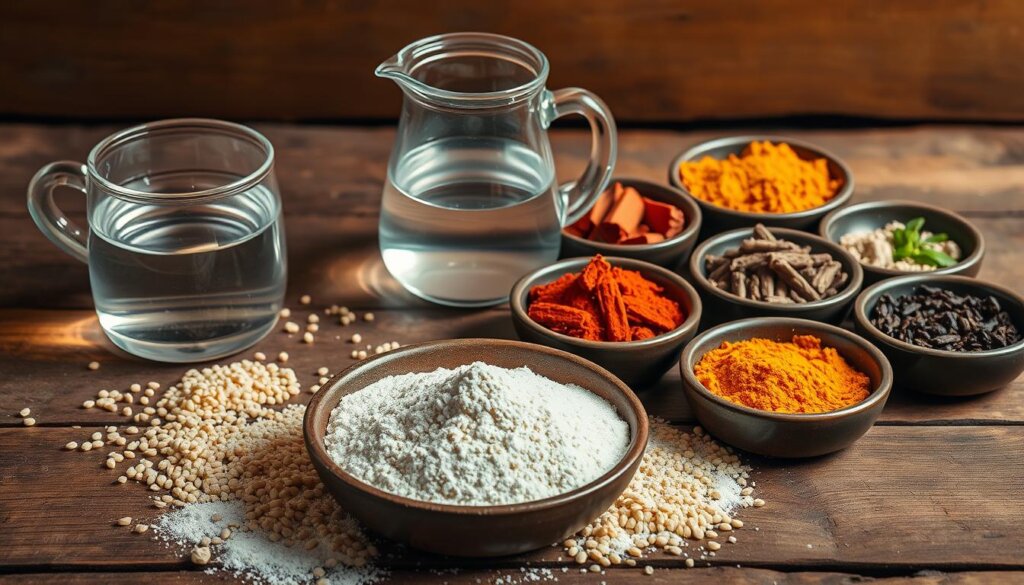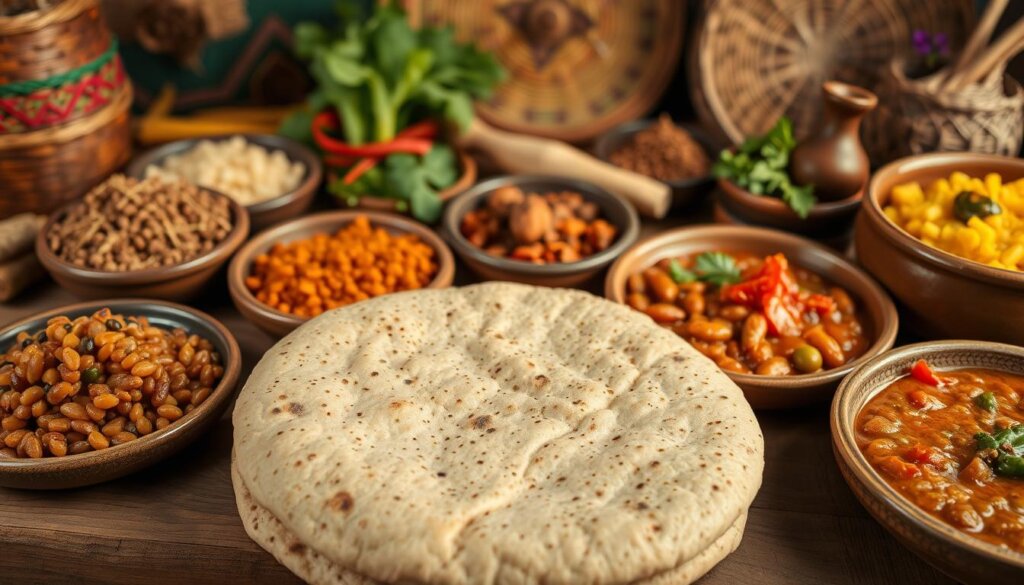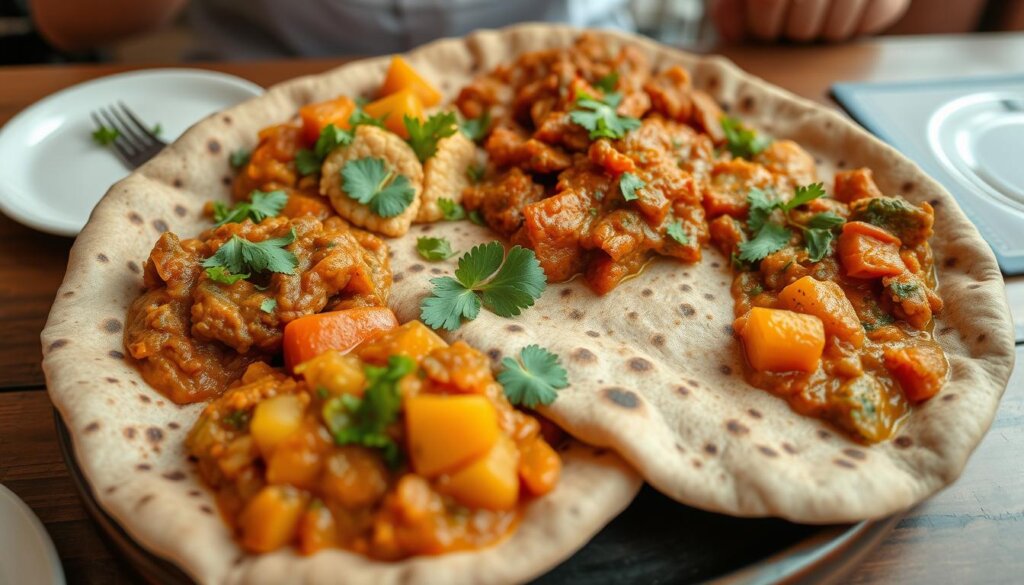Ever wondered if injera, your favorite Ethiopian flatbread, is gluten-free? Let’s examine its ingredients and how it’s made. Traditional injera is made with teff flour, a naturally gluten-free grain. However, some recipes might include wheat or barley flour, posing risks for those with gluten sensitivities.
For a safe gluten-free option, look for injera made exclusively with teff flour. This guarantees it aligns with a gluten-free diet. In this article, we’ll uncover the facts about injera, its health benefits, and gluten-free alternatives for your favorite dishes.
For more ideas, discover Gluten-Free Grains Guide, try a recipe like Gluten-Free Sourdough Bread, or discover Easy Gluten-Free Wraps.
Table of contents
- Understanding Injera and Its Ingredients
- Is Injera Gluten Free?
- Health Benefits of Injera
- Who Should Avoid Injera?
- Alternative Options to Injera
- Exploring Teff: The Grain Behind Injera
- Conclusion
- FAQ
- Is injera made with teff flour gluten-free?
- Can I eat injera if I have celiac disease?
- What are the main ingredients of injera?
- Are there gluten-free alternatives to injera?
- What health benefits does teff offer?
- How do I ensure the injera I eat is gluten-free?
- How long does it take to ferment injera?
- What should I consider if I have gluten sensitivity?
- Can I make gluten-free injera at home?
- What is teff?
Understanding Injera and Its Ingredients
Injera is more than just a food. It’s a big part of Ethiopian culture and food. It’s served in big portions, making meals fun and interactive.
What is Injera?
Injera is a spongy, sourdough pancake. It’s made from teff flour, a gluten-free grain. This grain has a rich, nutty taste.
The fermentation process is essential to making injera. It gives the flatbread its signature sour flavor and light, airy texture. Additionally, the fermentation time can vary, ranging from six hours to several days, depending on the recipe and desired taste.
Common Ingredients Used in Injera
The main ingredients are teff flour, water, and salt. Sometimes, a leavening agent is added to help with fermentation. Here’s a closer look:
| Ingredient | Role in Injera |
|---|---|
| Teff Flour | Main ingredient that gives injera its flavor and gluten-free quality. |
| Water | Used to create the batter and assist in fermentation. |
| Salt | Enhances flavor and controls fermentation. |
| Leavening Agent | Optional ingredient that helps improve texture. |
Many places mix flours, using some wheat flour with teff. This mix can make injera more structured. The right mix of ingredients is key for a great injera texture.

Is Injera Gluten Free?
Many wonder if injera is gluten free. This question often comes up because of its main ingredient, teff flour. Teff is naturally gluten-free, which is good news for those who can’t have gluten.
Traditional Injera Made from Teff
Injera is famous for its distinct taste and texture. Typically made mostly from teff flour, it is safe for gluten-free diets. Additionally, recipes often involve fermenting the batter for several days, which gives injera its signature sour flavor.
This fermentation makes injera special. It’s gluten-free because of teff flour. But, some recipes might use wheat or barley, which isn’t good for gluten-free diets.
Potential Gluten Contamination
Injera’s popularity has raised concerns about possible gluten contamination. Additionally, some places may prepare injera near gluten-containing foods, posing a risk for those with gluten sensitivities. Therefore, it’s essential to verify where your injera is made to ensure it’s safe to eat.
Make sure the place you get injera from follows strict cleaning rules. Always ask about the ingredients and how it’s made. This keeps you safe from gluten.

Health Benefits of Injera
Injera is a staple in Ethiopian cuisine and is made primarily from teff. Moreover, teff is a nutrient-dense grain that offers many health benefits. Understanding injera’s advantages and teff’s nutritional value can help you make better food choices. Additionally, teff flour is recognized globally for its richness in nutrients, bringing added health perks to your meals.
Nutritional Profile of Teff
Teff is very nutritious. It has about 12.2 grams of protein per 3.5 ounces (100 grams). This makes it a great protein source for those who don’t eat meat. Teff flour is also full of fiber, with up to 12.2 grams in the same amount. This fiber helps with digestion and keeps blood sugar steady.
Teff is also a good source of iron, giving you 37% of the Daily Value (DV). This is important for avoiding iron deficiency. These facts make teff a top choice for healthy foods.
Why It’s Considered a Healthy Option
Teff flour has more than just protein and fiber. It has a glycemic index of 57, which helps keep blood sugar stable. It has more fiber than wheat or rice flour, making it a healthier grain choice. The fermentation in injera also makes it good for your gut and insulin sensitivity.
These benefits make injera a great choice for a healthy diet. For more on teff flour’s benefits, check this source.

Who Should Avoid Injera?
Traditional injera is often seen as gluten-free because of teff. But, some people need to be careful. Knowing your dietary needs helps you choose wisely about injera.
Individuals with Celiac Disease
Those with celiac disease must watch out for injera. Teff is gluten-free, but some injera mixes in gluten grains like wheat. This can lead to gluten in the food.
Always check the ingredients and ask about the source of the injera. Additionally, not all places use 100% teff flour, which means there’s a chance of accidental gluten contamination.
People with Gluten Sensitivity
About 13% of the world experiences gluten sensitivity. Moreover, even a small amount of gluten can trigger issues for these individuals. Therefore, it’s crucial to ensure that injera is entirely gluten-free to avoid potential health problems.
Making injera at home with just teff flour is a good idea. This way, you know it’s safe for you. Making the teff starter right at home means your injera will be just right for you.
In short, people with celiac disease and gluten sensitivity should be careful with injera. Make sure it’s made only from teff. Knowing where your food comes from is important for staying healthy.
Alternative Options to Injera
Exploring gluten-free options can unlock a whole new world of flavors. For instance, you can discover flatbreads that closely resemble the taste and texture of injera. Additionally, there are many alternatives to choose from, including those made with legumes or gluten-free flours.
Gluten-Free Flatbread Alternatives
Here are some gluten-free options that can replace injera:
- Chickpea flatbread: It’s high in protein and has a rich flavor.
- Cassava flatbread: It tastes slightly sweet, making it great for both sweet and savory dishes.
- Teff flour crepes: These crepes use only teff flour. They keep the injera taste but are gluten-free.
- Buckwheat flour: It has as much protein and fiber as teff. You can use it the same way.
- Millet flour: It has less protein but gives a grainy texture like teff.
- Sorghum flour: It’s sweet and mild. It’s perfect for gluten-free baked goods.
- Amaranth flour: It has a nutty taste. It makes recipes denser.
How to Make Your Own Gluten-Free Injera
Here’s a simple recipe for homemade injera:
- Mix 1 cup of teff flour with 1 cup of water in a bowl.
- Add a pinch of salt.
- Mix well until smooth. Let it sit for 24-72 hours to ferment. This step is key for flavor.
- Preheat a skillet. Pour the batter and cook until bubbles form and the edges lift.
This recipe lets you make injera that’s gluten-free. It’s full of protein, fiber, and vitamins. It meets your dietary needs.
| Flour Type | Protein Content | Flavor Profile |
|---|---|---|
| Teff Flour | High | Earthy, nutty |
| Buckwheat Flour | Similar to Teff | Mild, nutty |
| Millet Flour | Lower than Teff | Nutty, slightly sweet |
| Sorghum Flour | Moderate | Mild, sweet |
| Amaranth Flour | Lower than Teff | Mildly sweet, nutty |
These gluten-free options and recipes are great for your diet. They offer delicious flavors and keep your diet balanced.
Exploring Teff: The Grain Behind Injera
Teff is the main ingredient in injera, the traditional Ethiopian flatbread. Moreover, it’s packed with nutrients and thrives in various climates. Additionally, understanding its health benefits and learning how it’s cultivated can improve your appreciation for this ancient and versatile grain.
The Nutritional Value of Teff
Teff is a top choice for those who care about their health. A ¼ cup of cooked teff has:
| Nutritional Component | Amount |
|---|---|
| Protein | 4-6 grams (complete protein with all 9 essential amino acids) |
| Manganese | 100% of the daily value |
| Iron | Rich source, essential for oxygen transport in the body |
| Calcium | Important for bone health |
| Flavonoids | High antioxidant activity |
The fermentation process in injera makes teff’s nutrients even better. Brown teff has more antioxidants than white teff.
How Teff is Grown and Processed
Teff grows best in specific conditions. It’s mainly farmed in Ethiopia and Eritrea. Despite old farming methods, teff grows well and yields a lot.
Harvesting teff includes cleaning and grinding it into flour, preserving its nutritional benefits. Moreover, teff’s mild flavor and increasing popularity have resulted in a wider range of products featuring this versatile grain.
Conclusion
When we talk about injera being gluten-free, it’s key to know that traditional injera is made from 100% teff flour. This makes it safe for those who can’t eat gluten. But, some recipes might use wheat or barley flour, which has gluten.
So, it’s important to check the ingredients before eating injera. This is true for people with celiac disease or gluten sensitivity. They need to make sure it’s safe for them.
Gluten-free injera is not just good for those who can’t eat gluten. It’s also full of fiber, iron, calcium, and protein. The way it’s made makes it easy to digest and good for your gut.
If you want to try injera, making it at home is a great idea. You can choose what goes into it. This way, you can make sure it fits your dietary needs.
In the end, injera is becoming more popular because it’s gluten-free. Teff, the main ingredient, is full of nutrients. Injera is tasty and fits well into a healthy diet.
FAQ
Is injera made with teff flour gluten-free?
Yes, traditional injera made with 100% teff flour is gluten-free. But, always check for any gluten in extra ingredients.
Can I eat injera if I have celiac disease?
If you have celiac disease, be careful with injera. Make sure it’s made only from teff flour. It should not mix with gluten grains.
What are the main ingredients of injera?
Injera’s main parts are teff flour, water, salt, and sometimes a leavening agent. Always check the source to avoid wheat or barley.
Are there gluten-free alternatives to injera?
Yes, there are gluten-free flatbreads like chickpea and cassava flatbreads. You can also make homemade injera with pure teff flour.
What health benefits does teff offer?
Teff is full of fiber, protein, iron, and B vitamins. It helps with digestion, energy, and muscle repair. It also has calcium and zinc for bones and immunity.
How do I ensure the injera I eat is gluten-free?
Always check the ingredients. Confirm with the restaurant or maker that it’s 100% teff flour, without gluten.
How long does it take to ferment injera?
Fermenting injera takes from six hours to a full day. This is key for its unique texture and taste.
What should I consider if I have gluten sensitivity?
With gluten sensitivity, be careful with injera. Cross-contamination can happen during processing or making. Always look for gluten ingredients.
Can I make gluten-free injera at home?
Yes, you can make gluten-free injera at home. Use teff flour, water, and salt. This way, you avoid gluten from other grains.
What is teff?
Teff is a tiny grain with lots of nutrients. It’s gluten-free and mainly grown in Ethiopia and Eritrea. It offers many health benefits.





